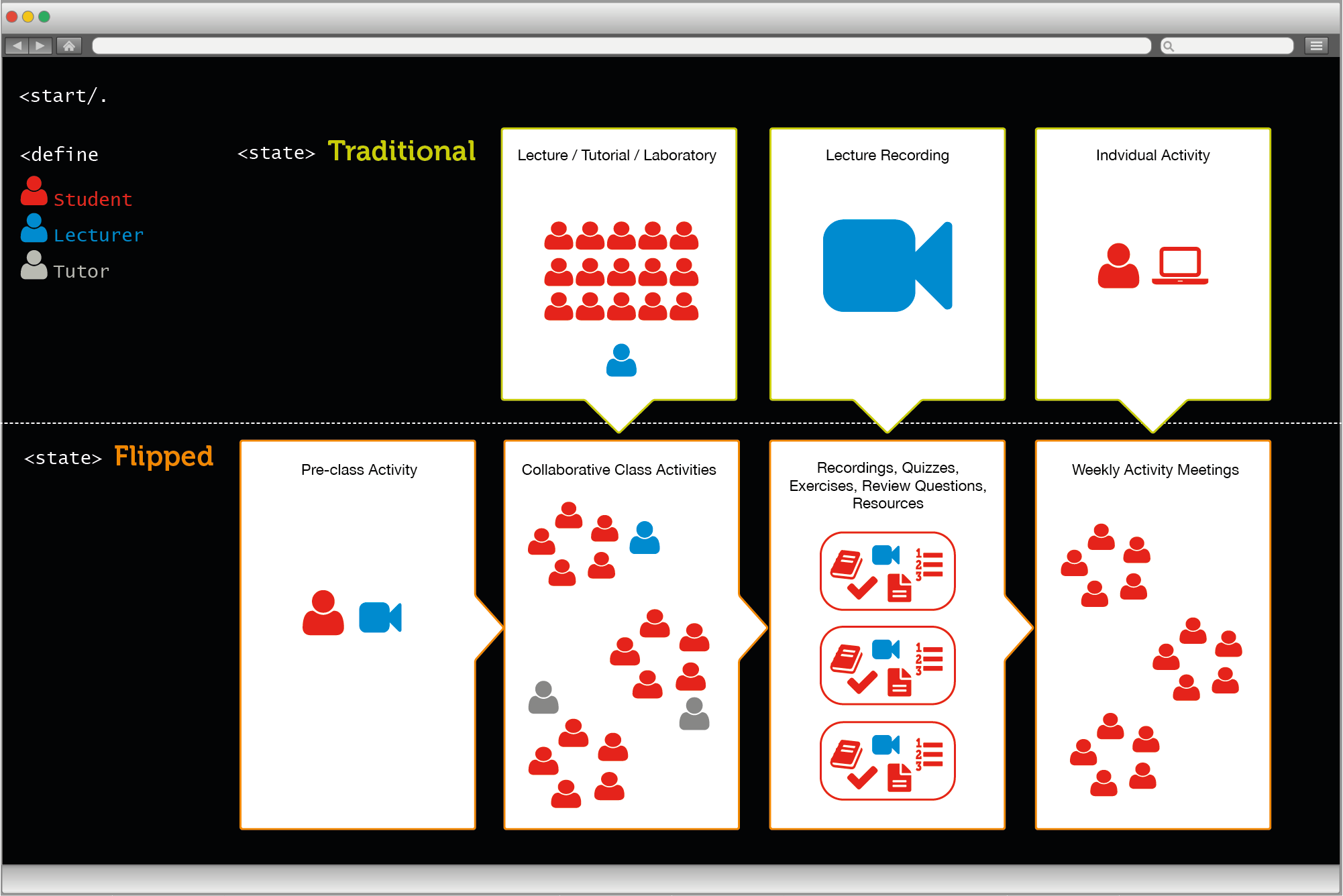Flipped Classroom for Delivery of Programming
Design Pattern Tags : Course, Learning engagement/activities, Blended learning, Flipped classroom, Group work
Flipped Classroom for Delivery of Programming Daryl D’Souza, Mercy Maleko, Craig Hamilton, Neil Goudge, Meg Colasante
December 2015
Abstract/Snapshot:
Programming is taught as of first year in Computer Science and cognate disciplines and is known to be challenging (to first year students). In CSIT the key first year programming course is Programming 1.
Typically, and this is a worldwide phenomenon, first year programming courses experience high failure and attrition rates.
Improvements in technology (social media, lecture recordings and rich preview capabilities) coupled with improved teaching and learning spaces have provided opportunities to employ the Flipped Classroom model for teaching programming.
Programming is “activity-intensive” and is best learned through doing (even collaboratively) and, in turn, is likely to benefit from a L&T model that represents a departure from the traditional methods.
Low attendances in traditional lectures (and even in tutorials) experienced in the recent past demands a new L&T model.
If successful, this pilot project could lead to the course being offered offshore, within OUA, nationally and internationally.
Feedback from both students and clients has been very positive, and a number of students have also been employed by companies involved in the course as a client.
Learning Context This pattern is applicable to learners who are typically students studying a foundation level (first year) programming course using Java as a vehicle for instruction.
It may be readily adapted to other language contexts.
Rationale If successful, this pattern could lead to the course being easily adapted to be offered offshore, within OUA.
Learning Design All delivery is directly related to the course and program learning outcomes and as a part of this project we were able to more accurately moderate this for our delivery in multiple locations including Vietnam.
Conditions/Critical Success Factors The learning materials available for self-learning before attending activity meetings needs to be learner friendly and to be available in a more accessible environment than is currently provided by Blackboard.
Activity meetings need to be carefully aligned with such learning materials, preferably also driven by how students are being assessed (and in turn their learning outcomes).
Resources/Technology All learning materials are available on the Blackboard shell for Programming 1, COSC1073.
The activity meeting material is available in the ViLLE collaborative tutorial based learning system. ViLLE is freely available at ville.utu.fi .
Case Studies/Implementation The traditional 2 hours of lectures,1 tutorial, 1 laboratory model of student contact was replaced by a 2 hours of class activities in which students worked collaboratively on class activities, and 1 laboratory. Apart from traditional delivery being retained in Weeks 1, 2, 11, 12 (this may well change over time) the activity meetings were attended by tutors who would otherwise be conducting individual tutorials.
Blackboard content was presented in a more user-friendly manner with past lecture recordings chunked into 15-20 minute recordings. Each chunk provided a recording, quizzes, tutorial and laboratory exercises, and review questions, as well as referral to resources such as textbook readings.
Content was developed for activity meetings (2 x one hour meetings per week in Weeks 3-10 inclusive). These attracted some (minimal) marks. Students needed to complete a subset (12) of all (18) activities to be eligible for full marks. The activities were aligned with what students had to access in terms of learning materials in the Blackboard.
Outcomes We believe that in line with Vygotsky’s social constructivism theory the activity classes (formerly traditional lectures) will result in deeper learning of course programming concepts, via the collaborative activities in the activity meetings. Indeed, anecdotally at least, students were observed to be resolving issues of conceptual understanding that might otherwise not be clearly understood sufficiently early, a problem encountered ;in the traditional delivery model. In that model students often carry misunderstandings for too long into semester, often resulting in a compounding of problems with conceptual understanding.
In addition to the more engaging experience in ;the activity meetings, learners are encouraged to continue their collaboration outside of classes. Moreover, teaching staff time is freed up to allow for greater reflection about improved teaching strategies through direct observation of student engagement over guided activities.
One major impact of the flipped delivery model for programming was that it was suited the learning styles of one cohort of students. They were prepared to study course material before their activity meetings, a desired aim of the flipped delivery.
On the other hand, a significant number of students require strategies to instill a transition to this “forward learning” culture. This in turn will challenge staff to develop suitable strategies.

